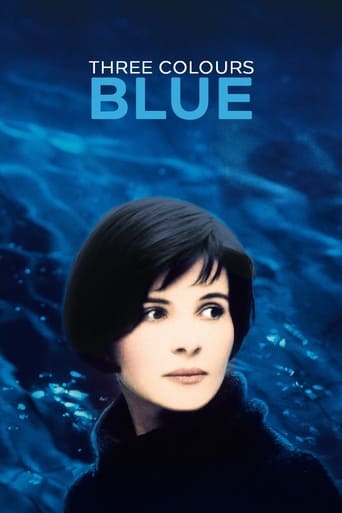alireza-akhlaghi84
Awesome and lovely blue movie is one of the three feature films of Kishlovsky's famous and well-known director of Poland.
As you can see, the trio of white and red were synonymous and complementary, but with separate stories that can be linked together.
With the sudden death of husband and child, life has found its diffrent way.
One kind of confusion is to find the way that July (the first character of story) is somehow calm, though superficial.
Finding this path at the start of the journey is in the form of a test and error, so that in the first place a story is an unconditionally close but divergent condition, and it is in the next departure.
The new way was so unclear that when July left the house forever, he dragged his hands to the wall, indicating a sort of punishment for escaping and not confronting the truth of the matter.
The path of the story goes as if the Miserables are not over; the suicide attempt, the confrontation of the mouses, the challenge of ejection the infamous woman, and the confrontation with Alzheimer's mother, completes the black puzzle.
However a fearless and conservative character perform the story of a passive and radical approach.
The fight against the baby mouses is somewhat radical to perform that the audience has not forgotten that at the beginning of the film, the first character of the story also saw her child's death.
Leaving the cat at home to fight the mouses and also tear off the music notes of the Alliance of Europe seems to be a clear indication of a kind of unconscious revenge as long as the story changed.
The confrontation with the mistress of the missing husband along with the child leads to the movie spin. As far as we can see, Kishlovsky's triple blue at the end continues the music.
In this movie, we see that the elements, although simple, are well displayed.
The blue necklace, the cross necklace, the flute player are frequent indications of the film, which is even attractive for repetitions.
Music in the film sometimes appears as an Aggressor, but Effective in the story line.
ayhansalamci
Blue, sky and sea are icons and they have a relaxing effect on human psychology. When we open our window every day or step on the street, the sky above us like an infinite dome is blue. We often see blue tones in the film. These colors that Julie confronts show her the transition to a peaceful life. In general I can say that I watched a great drama film. The use of musical stage and color is very successful. My favorite movie in the trilogy.
Nikonani S
I cannot be sure that Kieslowski cared much for the script of this film; otherwise he would not have made this 2-act film drawn out into the length of a 4-act. The symbols are there, elegantly shot perhaps, but not elegantly placed; the black screens and musical outbursts are overdone and obtrusive, to say the least. And when the widow, (shall we call her Ms. Blue? I don't remember her name) Ms. Blue, is given the cue for reflection (such as when waiting in the dark for an entire minute, deliberating on whether to open her apartment door to check on the remnants of a street fight), the actress "reflects" well -- but to what end? We get the feeling that Kieslowski is making a feature film from the pieces of a short film (what would be a fantastic short film!) and must slather a coat of cinematic, slow "art house" "reflective" paint over the missing pieces to hit a 80+ minute running time. Perhaps to make the film eligible for awards.It is a wonderful film, especially visually; unforgettable are the ultramarine swimming pool and a sugar cube absorbing coffee. But sugar cubes and swimming pools alone don't make for a feature film. The dramatic weight just isn't there, and the freshness of the visuals certainly don't mend the paucity.
Lee Eisenberg
"Trois couleurs: Bleu" ("Blue" in English) was the first entry in Krzysztof Kieślowski's Three Colors trilogy. Named after the colors on France's flag, the trilogy focuses on stories involving France's national motto: Liberty, Equality, Fraternity. Kieślowski said that "Blue" looks at emotional, rather than political, freedom, as Juliette Binoche's widow Julie is no longer bound by family life but can't fully escape her past. This continuing connection is embodied in the lamp of blue beads, and in the footage of bungee jumping (in which the cords become more apparent as the movie progresses, symbolizing evidence of a link to the past). Most importantly, there is the music: much like how music consists not of a single note but of harmony with other notes, Julie cannot stay isolated from the rest of the world. Thus it's an anti-tragedy: Julie's attempt to erase her past call into question whether love and freedom can coexist.This is the first Kieślowski movie that I've seen, and I'm really impressed. His use of scenery and colors to tell the story mirrors Stanley Kubrick's style of filmmaking. Juliette Binoche won both a Golden Globe and a César for her performance, as well as an award at the Venice Film Festival (all well deserved). As for the director, I hope to see the other entries in Kieślowski's Three Colors trilogy, as well as his other works. It's too bad that he retired after finishing the trilogy and then died of a heart attack.






